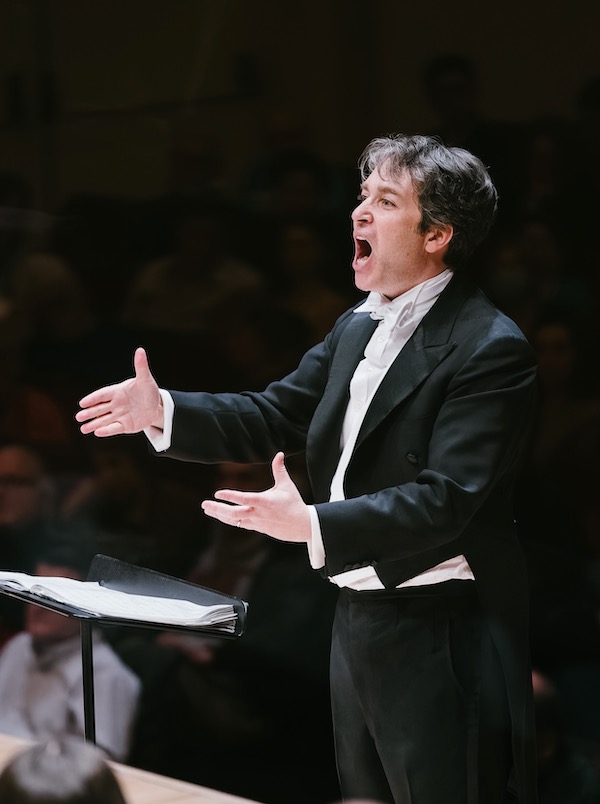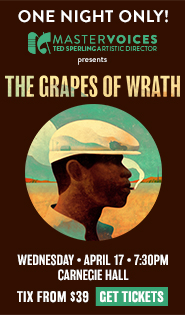Clarion Choir marks Rachmaninoff year with a moving Vespers at Carnegie

Steven Fox led the Clarion Choir in an exquisite and deeply moving performance of Rachmaninoff’s All-Night Vigil at Carnegie Hall on Friday evening.
This concert was part of Fox’s commemoration of the great Russian composer’s 150th birthday, which sees the conductor performing many of Rachmaninoff’s major choral works with his various choirs in New York and elsewhere. The Clarion Choir led off the Rachmaninoff series locally last New Year’s Eve with the composer’s Liturgy of St. John Chrysostom.
Rachmaninoff composed the Vespers, as the work is commonly known, in 1915, combining 12 prayers from the Divine Office—Vespers, Matins, and the First Hour—as well as three of his own compositions into a single work. The actual religious service, including hymns, readings, chants, and prayers, is an all-night vigil celebrated on the eve of the main feasts of the Orthodox Church calendar and lasting from sunset to sunrise. Rachmaninoff’s version for unaccompanied chorus and soloists takes around seventy-five minutes to perform.
Acclaimed as one of the leading vocal ensembles in the United States, the Clarion Choir is intimately familiar with Rachmaninoff’s Vespers, having just released a recording of the work on the Pentatone label. The same is true for its conductor, as the Vespers have resonated with Fox since university days, when he conducted it as part of a senior project. That familiarity undoubtedly accounts for the freedom and ease with which he conducts it.
The responsiveness of the 34-voice chorus to Fox’s instant changes of mood and dynamic levels was impressive. The suppleness of the singers’ sound and their flexibility permitted Fox to shape phrases and paint the meaning of words through sound alone. The latter is especially crucial for a meaningful performance of the Vespers, as the texts are in Church Slavonic, the liturgical language of the Orthodox Church.
Bass Glenn Miller and tenor Oliver Mercer intoned the call to prayer and response, traditionally sung by a priest and deacon, which opens the work. The choir then sang the “Come, let us worship,” the first movement of the work in an outpouring of robust, radiant sound that reached its emotional and dynamic climax in the final line of the prayer bidding all to fall down before the Lord.
In the second movement, “Bless the Lord, O My Soul,” an alto soloist sings a melody based upon a Greek chant to the accompaniment of alternating male and female choruses. In a break with Orthodox musical tradition, Rachmaninoff has the choir hum to create a drone-like effect that lends a sense of continual musical flow to the work. Mikki Sodergren, the soloist, displayed a fascinating earthy timbre in her voice that evocatively expressed the timeless, almost primeval emotions of these ancient rites.
Tenor John Ramseyer’s voice had a shining, clear, elegance that readily summoned the more ethereal moods that Rachmaninoff expressed in the fourth movement, “O Gladsome Light.” The final measures were memorable for the shimmering sound of the sopranos combined with the descending lines of the other three voices that depicted the last rays of sunlight at eventide. Ramseyer also sang with equal stye and beauty of sound in the fifth movement, “Now Lettest Thou Thy Servant Depart” and the ninth, “Blessed Art Thou, O Lord.”
The fifth movement was the composer’s favorite and he requested that it be performed at his funeral. It proved impossible, however, to assemble a choir capable of doing the music justice on that occasion—likely due to the lack of basses able to sing the descending scale that end on a low B-flat at the conclusion of piece.
Glenn Miller, however, is one such bass. The bass profondo’s imposing voice was first heard at the very beginning of the concert, but “Now Lettest Thou Thy Servant Depart” afforded the opportunity to savor its true grandeur. It was not only Miller’s cavernous sound that impressed, but the depth of emotion and spaciousness that he brought to enrich the chorus’ sound.
The ninth movement,“Blessed Art Thou, O Lord,” is a dramatic telling of Jesus’ resurrection and the visit of the three Marys to his empty tomb. The chorus’ articulation of the text “Both now and ever” summoned joy, as did the more subtle bell-like sounds with which the women sang the concluding Alleluias.
Sounds of triumph filled the hall in the final movement, “To Thee, the Victorious Leader,” a hymn to Mary, the Mother of God. At this point in the traditional vigil service, ideally sunlight would have been streaming into the church and it was that moment that Rachmaninoff captured in music and that Fox and his singers captured to perfection.
For an encore, the chorus repeated the Ave Maria, the last movement of the Vespers section of the work. The second time around, the singing was even more joyous.



